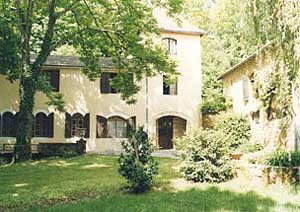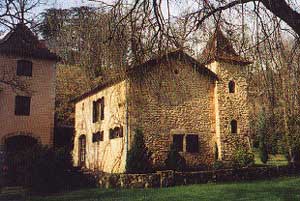|
|

MOULIN DE PEUCH
PERIGORD NOIR
1974 - 1983
|
In 1974 Johfra and Ellen bought a property in the Perigord Noir, a richly forested region in the south-west of France. This area was famous for its Paleolithic cave paintings, Celtic remains, and eventually became a centre for Buddhism as well. In this crossroads of so many cultural influences, Johfra and Ellen converted an old mill into their home, preserving the stream which ran under the house.
Over the years, Moulin du Peuch and its surrounding gardens expanded. At first Johfra maintained a studio in the tower, which overlooked the garden with its small waterfall, meditative pond with goldfish, enchanted forest and small pine tree which the two had brought from the Alpes Maritimes as a seedling.
Eventually, they built an addition which housed their newly-founded Galerie la Licorne, and Johfra transferred his studio to the space above the gallery, using a small adjoining alcove as his bedroom. In this way, he could sleep and wake with his paintings, or work through the night if necessary. By habit, he rose and began painting extremely early in the morning.
|
|
|
|
|
Aside from her own painting, Ellen managed the gallery and its publishing house, le Chant des Toiles (which means The Song of the Canvases. But, des Toiles sounds exactly like d’etoiles, giving it the second meaning The Song of the Stars). Though both of them continued to expose abroad, they became increasingly involved with the artists in their own region, publishing and exhibiting their work. At the same time, Dutch artists and students would descend from Holland to paint with them in the inspiring ambiance.
|

THE GALLERY AT MOULIN DE PEUCH
|
After the Zodiac Series, Johfra spent the next couple of years on a commission for Walter Kamp called the Maldoror Series. These constituted his darkest and strangest works. A definite change came over Johfra’s painting in the following years, as he moved away from Hermetic subjects and produced more Pantheist works.
These began with a painting of Hecate, then large depictions of witches’ sabbaths, and reached their peak with the huge Adoration of Pan triptych. Here as well the subject matter was dark and gloomy. But over the 80’s, a different light emerged in Johfra’s works. Satyrs, elves, griffons and unicorns were depicted in rich bucolic settings, the sun’s natural light diffused through the trees.
|
|
|
|

